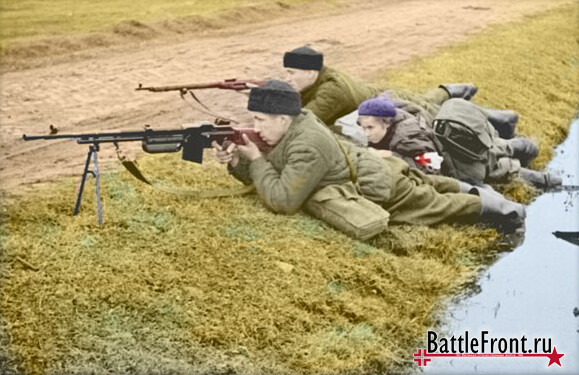… but rather it was the only thing in the class available to the US Army or USMC company.
Okay, that raises another interesting (to me, anyway) question: what about the Johnson LMG? I understood it was liked well enough by the soldiers, and was used by specialized forces in the ETO as well. But I’ve have gotten the impression that the USMC more or less abandoned the weapon after the initial phases of the war? Or is that a misconception – I just don’t seem to recall reading anything about Johnson LMG use in the Pacific in the mid-late war?
Because LMGs and GPMGs are considerably heavier and more ammunition hungry than a rifle the gunner carrys the weapon and some ammo, his second carrys the spare barrel and extra ammo.
I knew that was how soldiers in armies using the Bren, etc., worked , but I didn’t know the BAR was treated that way. Interesting…
The US Army offcially issued only one per rifle squad throught the war. Veteran infantry units usually scrounged more and it was not unusual to find two in a squad.
Hi Carl, you seem to know a lot about US squad TO&E; any chance your knowledge extends to other nationalities? Anyway, I’ve also read that in v. late 44 of 45, the US Army in the ETO did change to a two-BAR-per-squad organization? Or maybe that was just for specialized units, paratroops or whatnot? I did get the impression it was “official,” but… And it certainly isn’t easy finding in-depth sources dealing with this subject. Any recommendations? 
Interestingly, the US Army also developed a full automatic-conversion kit for the M1903 Springfield!
I don’t think I’ve heard of that! Was it actually used in combat, or just an experimental sort of thing?
…but the idea scrapped because of US high command fears of ammunition usage…
Funny how many nations sang songs like that one, isn’t it? I seem to recall that argument rising again and again in discussions of arms development/adoption by armed forces…
It seems like the idea of extra ammo/mags being carried by other squad members is the key to whether or not a weapon is a crewed/individual weapon? I had always thought it was a little bit more involved than that: but then, I hadn’t known the BAR was treated that way either. I guess my impression was also shaped by accounts of “assault rifle” use (though nobody said anything I recall concerning removing the bipod!). For example, a local newspaper recently had an article about a local USMC vet, who described his combat experience with one and how soldiers were “always” looking to abandon their garands in favor of the BAR’ greater firepower. The vet was a late-war rifleman, but he observed how he always wound up holding a BAR after an action – and the same thing with other soldiers as well. I wonder what happened to such field-acquired weapons: confiscated because of the ammo consumption concern? I mean – if this was just the individual’s preference in weapons, why didn’t his NCO make him a BAR man instead of always returning a rifle to him? Maybe that would be a topic for another thread – how soldiers were/were not able to deviate from standard organization tables and use personally-acquired weapons?






